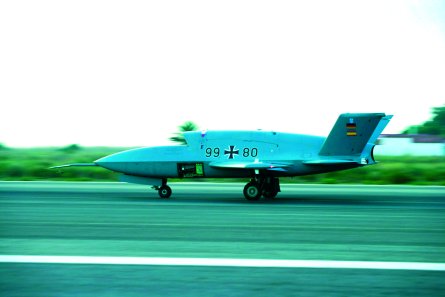Craig Hoyle / London
|
| The Barracuda unmanned combat air vehicle is powered by a Pratt & Whitney Canada JT15D turbofan engine |
EADS will publicly display its Barracuda unmanned combat air vehicle (UCAV) technology demonstrator for the first time at this week’s Berlin air show, fresh from conducting a 20min first flight of the 3t aircraft. The company has provided first details of the fully autonomous sortie, which was conducted from San Javier air base in southern Spain last month.
Developed over three years and manufactured at the company’s Augsburg and Manching plants in Germany and at EADS Casa’s Getafe site near Madrid, the Barracuda is powered by a Pratt & Whitney Canada JT15D-5C turbofan engine, providing a maximum speed of Mach 0.8. Its 8m (26.2ft)-long carbonfibre composite airframe has a 7m wingspan, triplex flight control and navigation system and uses electro-mechanical actuators to power its control surfaces.
First photos of the company-funded demonstrator appeared earlier this year during ground testing at Manching (Flight International, 14-20 February).
EADS plans to resume flight tests later this year and is seeking customer funding, possibly from Germany’s BWB defence procurement agency, European governments and industry. “Involvement in [Europe’s Dassault-led] Neuron UCAV demonstrator project doesn’t exclude participation in our programme,” says an EADS source.
Future testing is expected to include integration of electro-optical/infrared and synthetic-aperture radar (SAR) sensors, laser designation and emitter location systems, and perhaps air-launched weapons, says EADS. It plans to secure expanded flight clearance for the demonstrator at a remote test range before advancing towards certification to operate the unmanned aircraft in non-segregated airspace.
Source: Flight International




















